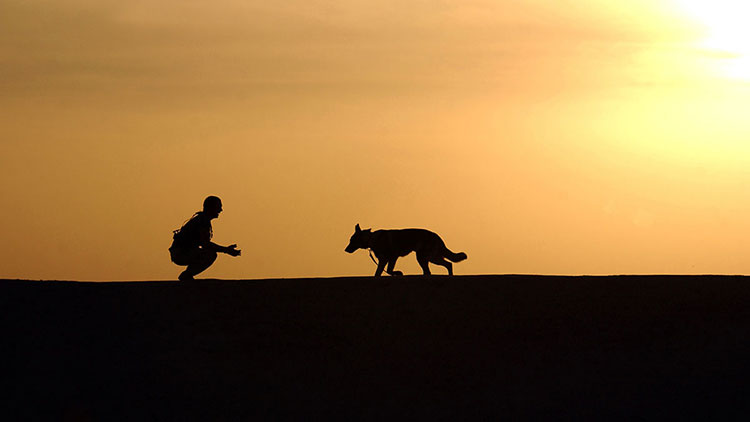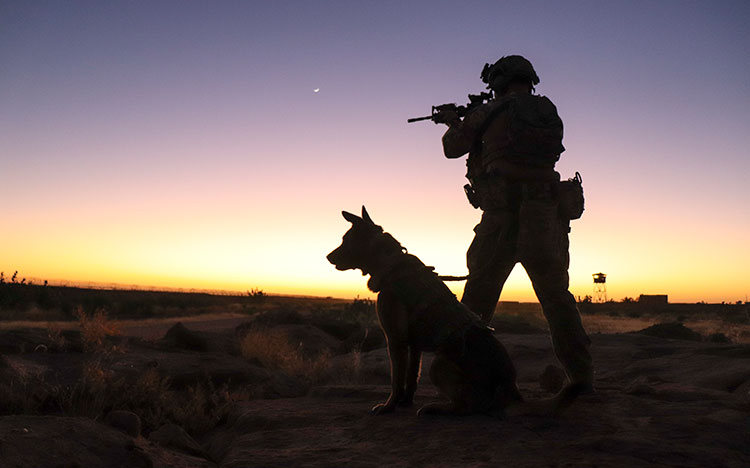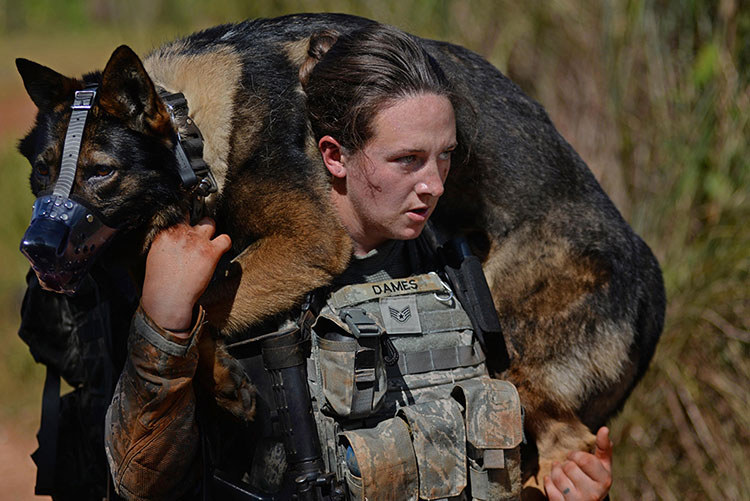
When it comes to training man’s best friend to also offer security and utility, what better place to look than U.S. military dog training?
This article will cover the best resource on training a K9 the way the U.S. Department of Defense does, detailed in the US Military’s Dog Training Handbook. This is the guide for training military working dogs.
Dogs in Survival Situations
Dogs are commonly discussed as being a part of various preppers’ preparedness plans, but those discussions are typically centered on whether you’re better to have a dog or not; and if you have a dog, which dog is the best for survival. Less commonly discussed is how to actually use that dog in a survival situation; and ultimately, how to train it.
It should be no surprise to anyone that dogs have many uses, particularly in survival situations. Dogs have a long history of use in warfare. Soldiers have known their value since ancient times. Egyptians, Greeks, and Romans all used dogs in warfare. Dogs were trained in combat, as scouts, guards, and as trackers.
In ancient times, dogs, often a large mastiff, would be strapped with armor or spiked collars and sent into battle to attack the enemy. They were (and are) also commonly used for search and rescue duties. Intimidation is another use, and – of course – therapy. The latter is becoming increasingly popular – therapy dogs. And after the apocalypse hits, everyone will need some therapy.
Dogs and Prepper Fiction
Dogs have also long had a place in prepper fiction. Think of the post-apocalyptic movies with a dog as a prominent character:
- Mad Max had his Australian Cattle Dog in Road Warrior.
- Will Smith, playing Dr. Neville in I Am Legend, had Abbey, his German Shepherd who was both a loyal companion and defender.
- There was even the odd 1975 post-apocalyptic classic A Boy and His Dog where the dog was one of two main characters.
- You even get a dog, Dogmeat, in the popular video game Fallout 4.
It’s clear that the idea of surviving the apocalypse with your dog at your side is widely shared.
Military Dog Training
So, assuming you’re in the “have a dog” camp, how do you actually train that dog so it can best assist you in a survival situation? Teaching your dog to “stay,” or “beg,” or even bark at strangers are pretty easy tasks that don’t require much know-how on the part of the trainer. But when you start getting into more advanced security-type training, that’s when the trainer needs training. Where better to look for that training than from the U.S. Military Working Dog (MWD) Program?
This is the military dog training program that teaches soldiers how to train dogs for all kinds of tasks associated with service and combat. Soldiers that undergo this training go on to become a Military Working Dog Handler.
Military Working Dog Program

The U.S. military has a distinct and critical dog training program for their K-9 comrades. An Army.mil article states:
“They make this job look easy. But make no mistake, without extensive and continuous training, the Army wouldn’t have any military working dogs.
Many consider the dog-handler profession to be an art form as there are so many nuances that the human must be able to interpret. Indeed, not just anyone can step in and perform the job. The hours are long, and the missions require the kind of autonomy that not everyone is mature enough to handle. Then, there are the dogs, which have distinct personalities just like humans do.”
The Training Manual
This Military Working Dog Program comes with its own manual, of course – the U.S. Military’s Dog Training Handbook. This is the paperback version of the United States Air Force Working Dog Program Manual (31-219), and short of actually going to school for training, this is about the best information you’ll find on the subject.
- Defense, Department of (Author)
- English (Publication Language)
- 190 Pages - 11/23/2019 (Publication Date) - Prepper Press (Publisher)
The Good
You can find countless books on how to train your dog, but this one is unique in that it is specific to combat-related training. For preppers, this is the type of training you are most likely to want for collapse and post-collapse skills you want your K9 to have. The reader will gain knowledge on the different types of conditioning and behavior modification. There is a chapter on patrol dog training that covers obedience commands, agitation, tracking, building search, etc. You can learn how to use decoys, rewards, address learning curves, and more.
The book has training for you, too. More than just knowing how to train your dog, the book has an entire chapter devoted to veterinary skills. It’s not as complete as the U.S. Army’s Guide to Veterinary Care of Military Working Dogs, but it does cover the basics: performing a physical exam of your dog; first aid for a bleeding wound, heat injury, abdominal wounds, etc.; how to induce vomiting; applying bandages; first aid kits; and more.
The Bad

Military manuals are not always written in the most reader-friendly manner. They are dense and often reference various military programs and use unique acronyms.
Short of a book like the U.S. Army Survival Guide, which assumes you are trying to survive on your own, military manuals are also written in the context of a large support system.
This book is no exception. For example, the book describes how to perform cardiopulmonary resuscitation on a dog (good to know), but also describes the administration of subcutaneous fluids. That’s great if you have a medic in your party, but for the post-collapse dog owner, only if you have access to such medical equipment.
The book could have used more diagrams and instructional photos. These aren’t entirely necessary for most topics discussed, but they would help in some instances.
Handbook Verdict
This book can’t be all things to all people, and while I don’t care for the few pages devoted to things like completing administrative records, the book does cover important training know-how for serious dog owners who see their dog as an integral part of their preparedness plans.
But the reality is that dog owners see their pet as being more than just a part of one’s preparedness plans. Dogs become part of the family, and dog owners see them as such. This makes giving them proper training more than just an act of self-preservation or preparedness.
Dog owners put considerable time and money into their pets. From that perspective alone, the book is well worth the purchase price when compared to the years’ worth of dog food and veterinary bills you’ll inevitably incur.
Further Reading
If you are looking to round out your reading on military dog training, the next step would be learning about dog health and treatment, i.e. veterinary services. There are plenty of books on this subject, some more technical than others, but the following two books are specific to military training.
U.S. Army’s Guide to Veterinary Care of Military Working Dogs
This book will cover the subjects covered by soldiers studying veterinary services.
- Veterinary Services, U.S. Army (Author)
- English (Publication Language)
- 170 Pages - 12/03/2019 (Publication Date) - Prepper Press (Publisher)
The Complete Military Working Dog Manual
This book is actually two books in one. It is a combination of the Military Working Dog Handbook described in this article and the above Guide to Veterinary Care of Military Working Dogs. If you want one book or the other (or both books as individual guides) buy them separately. If you want both books and you want to save a few dollars, this book is a better option.
- Defense, Department of (Author)
- English (Publication Language)
- 190 Pages - 11/23/2019 (Publication Date) - Prepper Press (Publisher)
What are your thoughts? Do you own a dog and if so, how do you train it? Let us know in the comments.


